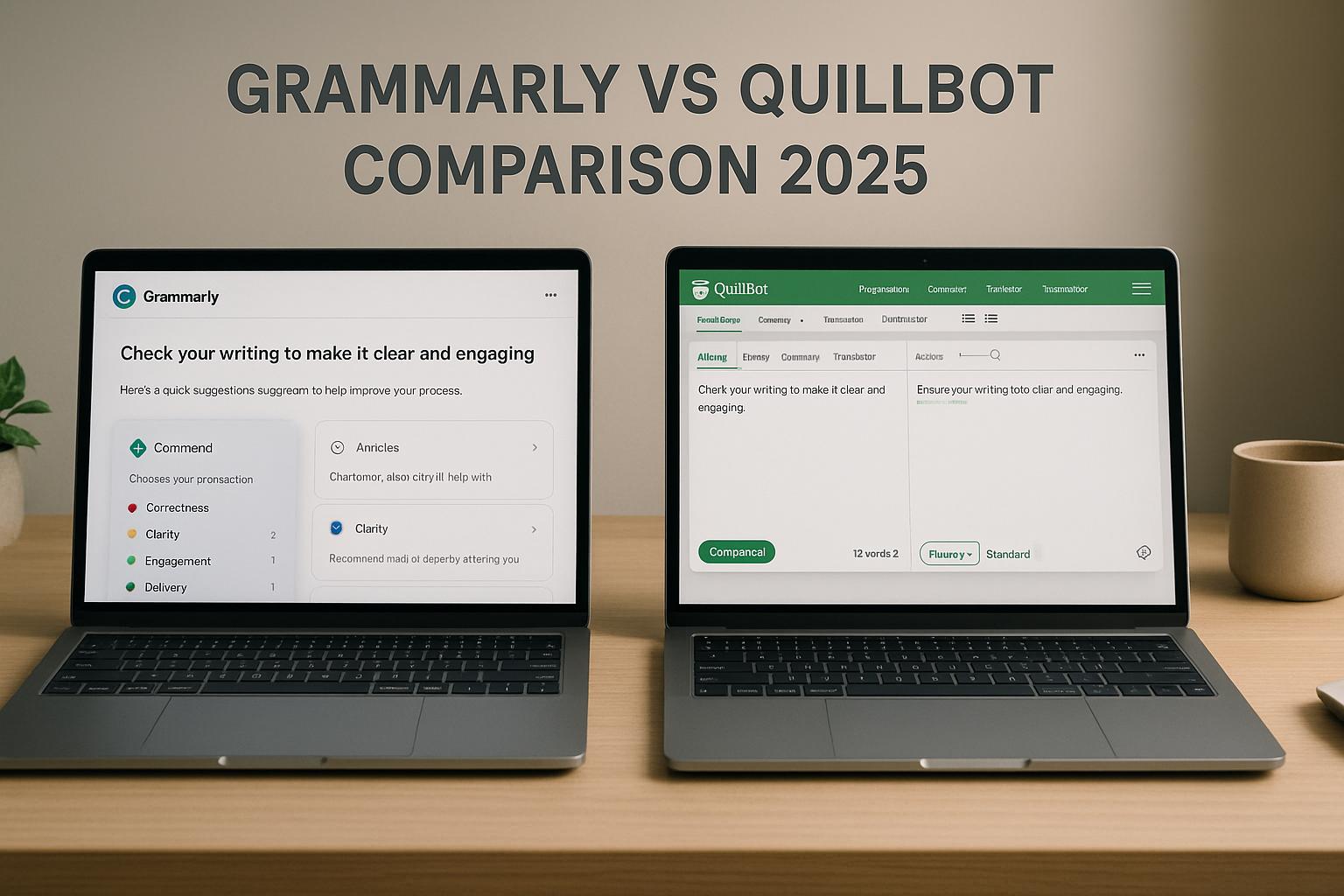Across industries, businesses are turning to low-code AI workflow tools to simplify operations without needing advanced coding skills. These platforms combine artificial intelligence with user-friendly interfaces, helping teams manage tasks like document categorization, customer inquiries, predictive maintenance, and content generation.
Here are the 7 tools highlighted in the article:
- Vellum AI: Focuses on large language models (LLMs) for workflows like semantic search and document processing. Offers a drag-and-drop interface and flexible AI integrations.
- Creatio: Combines workflow automation with CRM and case management, ideal for customer journey mapping and process improvement.
- Kissflow: Simplifies workflow creation with templates for tasks such as onboarding and approvals, enhanced by AI-driven task routing.
- Zapier: Automates tasks across 6,000+ apps with its trigger-action model, making it easy to connect tools without coding.
- Gumloop: Limited information available, but emphasizes visual workflow creation and team collaboration.
- FlowForma: Designed for process management, offering form automation and compliance-focused features.
- Domo: Integrates business intelligence with low-code automation, using a credit-based pricing model for data-driven workflows.
These tools cater to different needs, from AI-first workflows to customer management and data visualization. Evaluate factors like pricing, integration capabilities, and scalability to find the right fit for your business.
Build Your First AI Workflow | Free, Easy, No-Code, Step-by-Step Tutorial | AI Agent Series (Pt 1)
1. Vellum AI
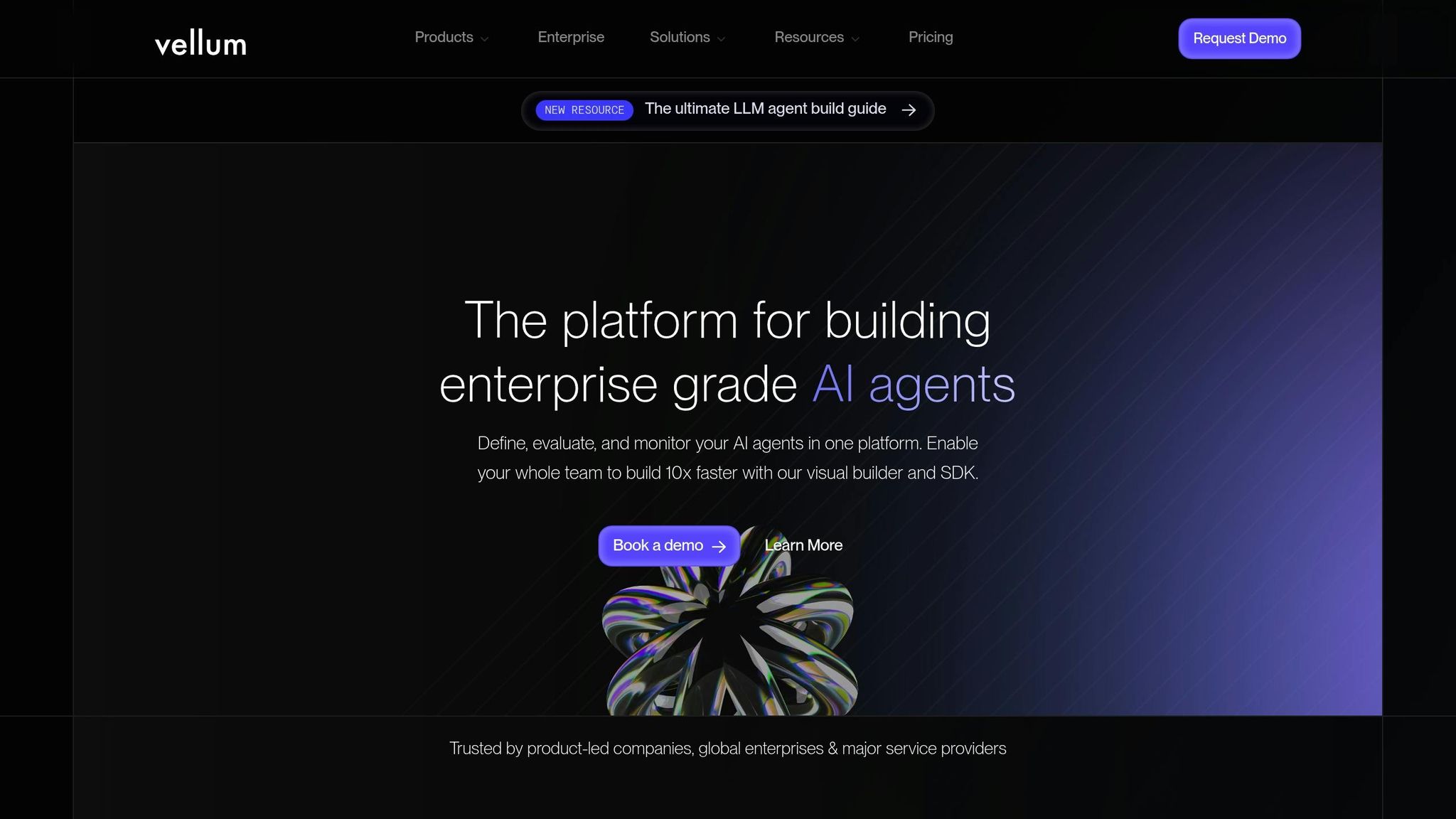
Vellum AI connects technical and business teams by placing large language models (LLMs) at the core of AI workflow design. It’s an ideal solution for companies aiming to incorporate conversational AI and text processing into their operations.
Low-code accessibility
With its visual drag-and-drop builder, Vellum allows business analysts to create AI workflows without writing code. At the same time, developers can step in to add custom integrations when needed. This combination makes it easy to start with simple workflows and gradually introduce more complexity as teams become more experienced with AI.
One standout feature is Vellum's prompt engineering tools, which let users test and tweak AI prompts in real time. This eliminates the usual back-and-forth between business teams defining the requirements and technical teams implementing them. The result? Faster, smoother AI integration.
AI integration capabilities
Vellum supports multiple LLM providers, including OpenAI's GPT and Anthropic's Claude, allowing teams to switch between services without rebuilding workflows. This flexibility helps businesses avoid vendor lock-in and manage costs effectively by using the right model for each task.
The platform shines in semantic search and document processing workflows. For example, companies use Vellum to automatically sort customer support tickets, pull essential details from contracts, or create personalized responses based on a customer’s history. Its built-in vector database integration also simplifies retrieval-augmented generation (RAG) workflows, eliminating the need to manage separate infrastructure.
Workflow customization and scalability
Vellum takes customization and scalability seriously. It offers features like version control to track changes and a monitoring dashboard that provides data on response times, accuracy, and costs. These tools make it easier to fine-tune workflows and ensure they run efficiently.
Pricing transparency
Vellum uses a usage-based pricing model, charging based on the number of AI model calls and the volume of data processed. Clear cost breakdowns help teams budget effectively and optimize spending.
For smaller teams or those testing the waters, Vellum provides a free tier with up to 1,000 AI model calls per month. Paid plans start at $50 per month for higher usage, while enterprise plans offer dedicated support and advanced security features for larger deployments.
2. Creatio
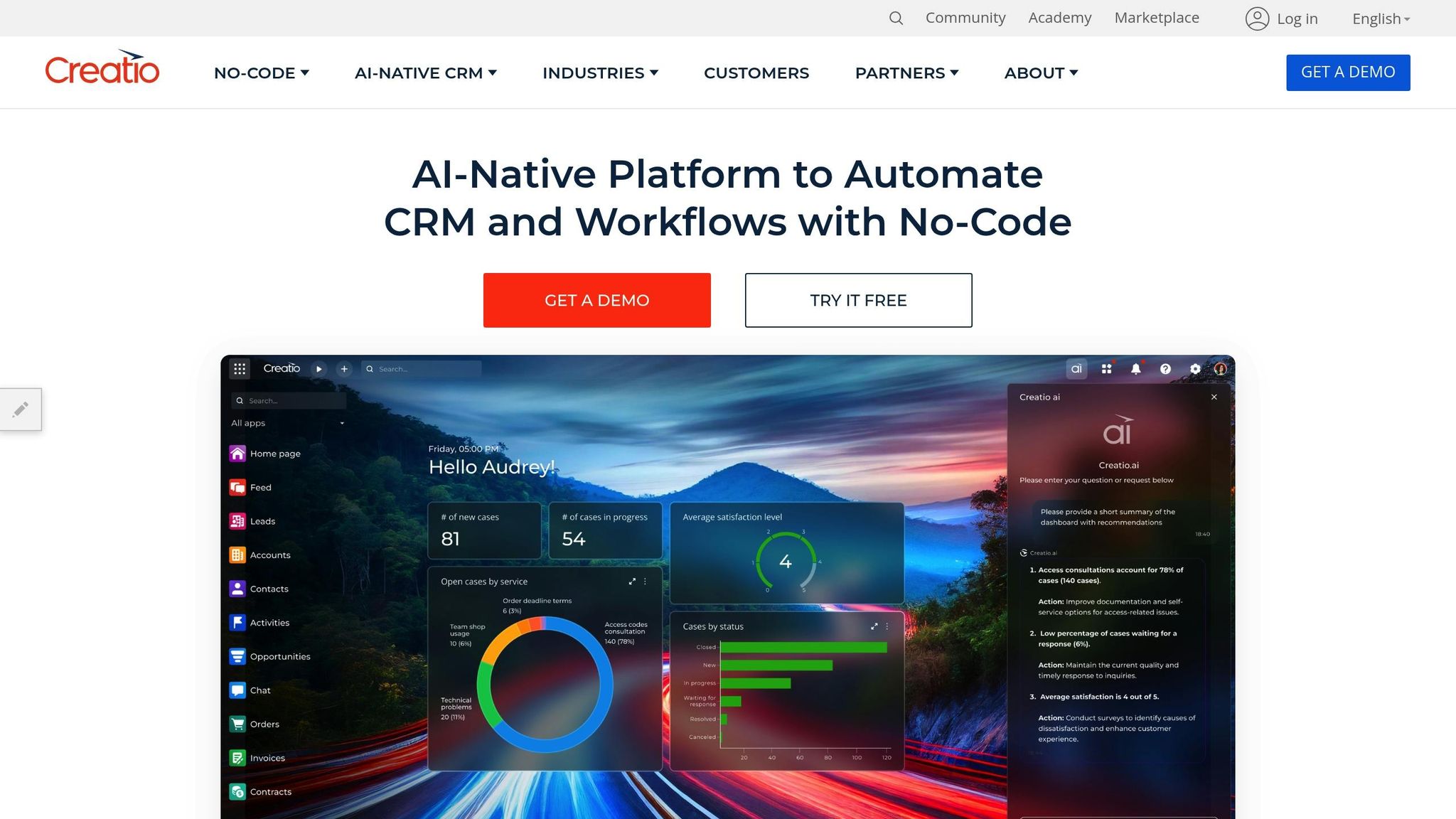
Creatio stands out in the low-code world by combining AI with robust process management tools. It brings together CRM, case management, and workflow automation into one platform. Rather than focusing solely on AI workflows, Creatio integrates artificial intelligence into broader business processes, creating a more holistic solution.
Low-Code Accessibility
With its visual process designer and drag-and-drop interface, Creatio makes it easy for users to design workflows, map customer journeys, and set up automated notifications. The platform also includes customizable forms and dashboards that can adapt as business needs evolve. This user-friendly approach sets the stage for integrating AI into everyday operations.
AI Integration Capabilities
Creatio leverages AI to streamline workflows and boost efficiency. By analyzing historical data, it identifies bottlenecks and offers suggestions to improve processes. These insights help teams prioritize tasks effectively and enhance how they engage with customers.
Workflow Customization and Scalability
For larger organizations, Creatio supports intricate, cross-department workflows with secure, role-based access controls. Its adaptable framework allows businesses to tailor processes to their unique needs while maintaining secure data management. This flexibility ensures it can scale with growing operational demands.
Pricing Transparency
Creatio provides tiered pricing options suitable for businesses of all sizes. Pricing details are available directly from the vendor, allowing companies to choose a plan that aligns with their goals and budget.
3. Kissflow
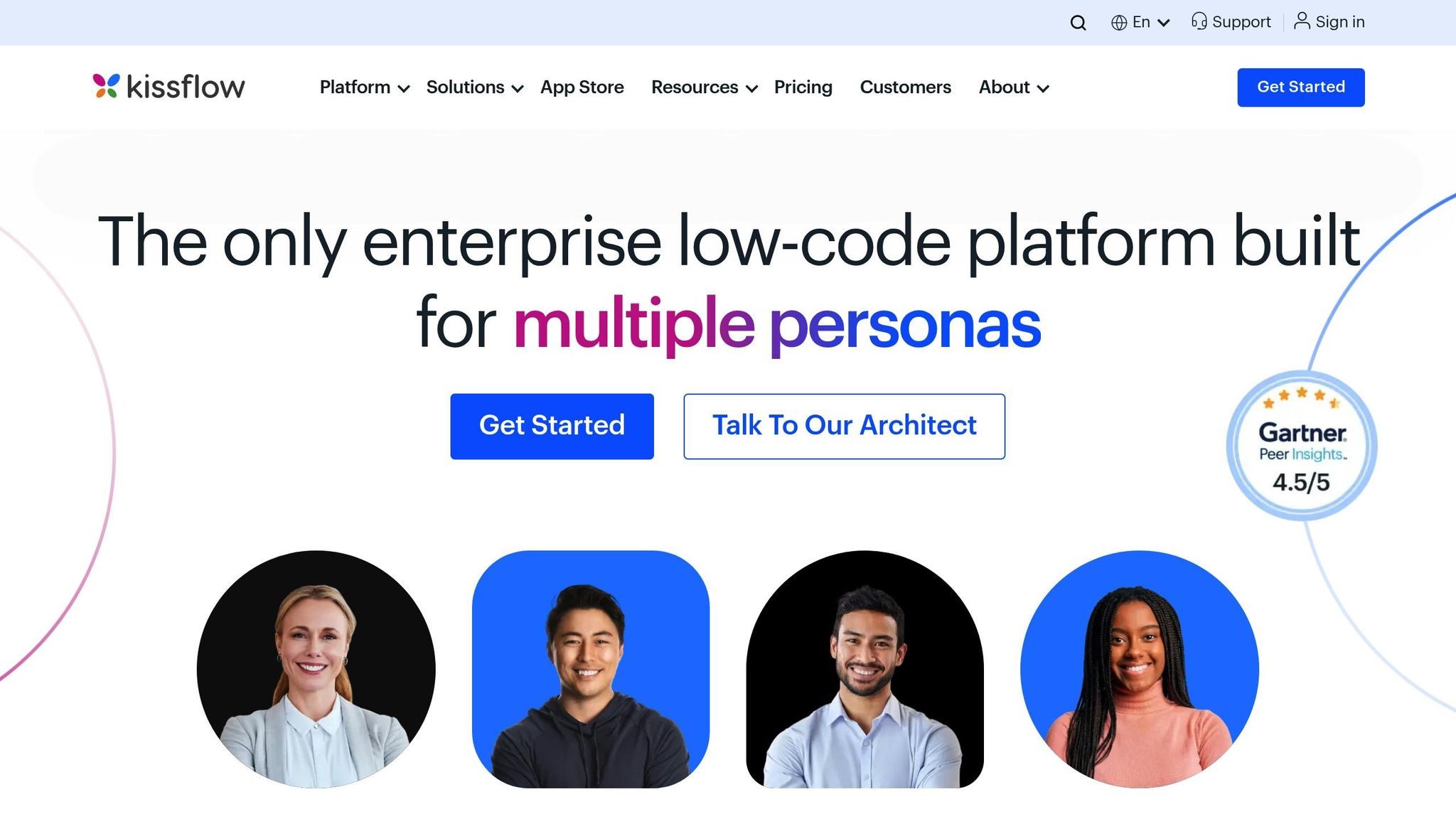
Kissflow is a digital workplace platform designed to simplify workflow automation. Instead of requiring deep technical expertise, it empowers business users across various departments to create and manage workflows with ease. By blending process management with collaboration tools, Kissflow enables teams to build and refine workflows without relying heavily on IT support.
Low-Code Simplicity
Kissflow features a user-friendly visual workflow builder that uses a drag-and-drop interface, making it possible to design complex processes in just minutes. The platform comes with pre-built templates for tasks like employee onboarding, expense approvals, and project management. Users can easily customize forms with different field types, add conditional logic, and set up approval hierarchies. Its intuitive design ensures quick adoption across teams.
AI-Driven Efficiency
Kissflow integrates AI tools to boost productivity and streamline operations. Its AI engine can intelligently route tasks, predict analytics, and identify bottlenecks in workflows. Tasks are automatically assigned to the most suitable team members based on factors like workload, expertise, and availability. Additionally, the platform leverages machine learning to provide insights into process performance, including cycle times and resource allocation, helping organizations optimize their operations.
Customization and Scalability
Kissflow caters to a wide range of workflow needs, from straightforward approval processes to complex, multi-department workflows. The platform supports dynamic routing that adjusts based on specific conditions or data inputs. Teams can configure role-based permissions, create custom dashboards, and set up automated notifications. Whether for small teams or large enterprises, Kissflow’s cloud infrastructure ensures smooth scaling, handling increased workflow demands without compromising performance.
Transparent Pricing
Kissflow offers a clear pricing structure with three main tiers. The Basic plan starts at $1,500 per month for up to 50 users, while the Advanced plan is priced at $3,000 per month for up to 100 users. For larger organizations, Enterprise pricing is available through consultation and includes additional security features and dedicated support. All plans include unlimited workflows and processes, with differences primarily in user limits and customization options. A 15-day free trial is available for those who want to explore the platform’s capabilities. Up next, we’ll dive into another platform that combines low-code tools with AI-driven workflow optimization.
4. Zapier
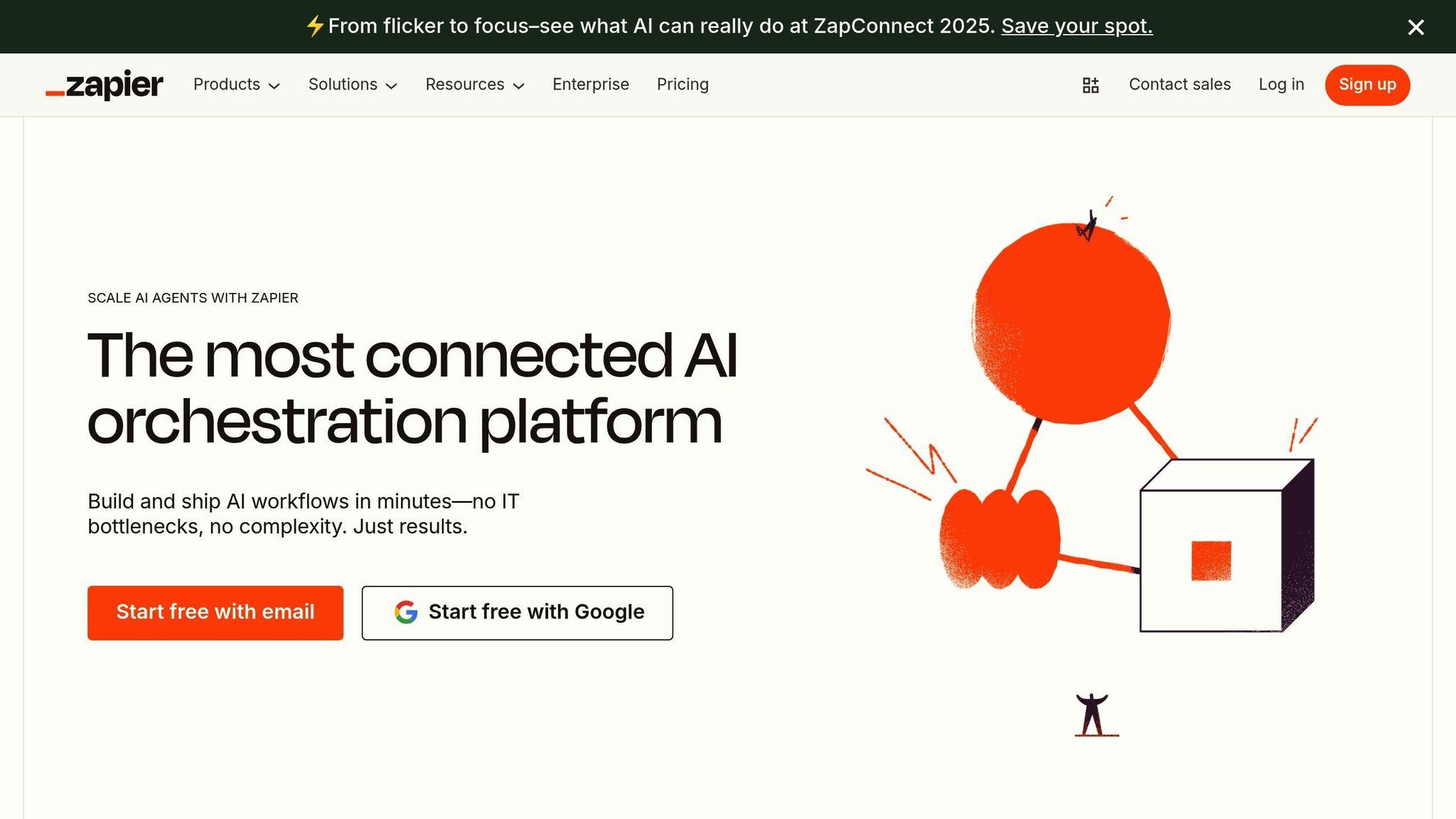
Zapier has carved out its place as a go-to tool for low-code automation, connecting over 6,000 apps without the need for coding. It transforms repetitive tasks into automated workflows, known as "Zaps", making it an excellent choice for businesses aiming to simplify operations across various software tools. Unlike traditional integration platforms that often require technical know-how, Zapier empowers users of all skill levels to create powerful automations.
Low-Code Simplicity
Zapier thrives on ease of use. Its trigger-action model lets users set up automations by selecting a trigger event from one app, which then prompts actions in other connected apps. Building a Zap involves just a few steps: choose a trigger, pick an app, and define the resulting action. The platform's visual editor offers step-by-step guidance, complete with real-time testing to ensure everything works perfectly.
For added convenience, Zapier provides thousands of pre-designed templates. For example, you can automate saving Gmail attachments to Google Drive or turn Slack messages into Trello cards. These templates can be customized, or users can start from scratch for more tailored workflows. Multi-step Zaps allow you to link multiple actions to a single trigger, enabling complex automation chains - all without touching a line of code.
Smarter Automation with AI
Zapier's AI features take automation to the next level. The platform suggests apps and actions based on your activity, helping you uncover new ways to streamline processes. Its AI-driven recommendations highlight popular automation setups and workflow patterns, saving time and boosting productivity.
Zapier also integrates with cutting-edge AI tools like OpenAI's GPT models. This means you can automate tasks like content creation, email summarization, or data analysis and seamlessly route the results to other apps. These capabilities let businesses harness AI power without needing a technical team, bringing advanced automation within reach for everyone.
Customization and Enterprise-Ready Features
Zapier offers robust customization options, including conditional logic and filters. This allows workflows to adapt based on specific criteria, making them more dynamic. The platform also supports data formatting, text manipulation, and even mathematical operations, enabling users to handle complex data processing tasks with ease.
For larger organizations, Zapier provides tools for team collaboration, such as shared folders, centralized billing, and user management. It’s designed to handle high-volume automations efficiently, with premium plans supporting unlimited Zaps and access to advanced features like webhooks, API connections, and custom code steps. These features make it an excellent fit for enterprise-level needs.
Transparent Pricing Structure
Zapier uses a task-based pricing model, making it easy to understand what you’re paying for. The Free plan includes 100 tasks per month and supports up to five single-step Zaps. The Starter plan, at $19.99 per month, offers 750 tasks, while the Professional plan, priced at $49 per month, supports 2,000 tasks and includes multi-step Zaps, premium app integrations, and advanced features.
For businesses with more demanding automation needs, the Team plan starts at $399 per month and includes 50,000 tasks, team collaboration tools, shared workspaces, and priority support. Enterprise-level plans are available for organizations requiring custom task limits, advanced security, and dedicated support. Users can track their task usage through detailed analytics, helping them optimize their workflows and manage costs effectively.
Up next, we’ll explore another platform pushing the boundaries of automated workflow design.
sbb-itb-212c9ea
5. Gumloop
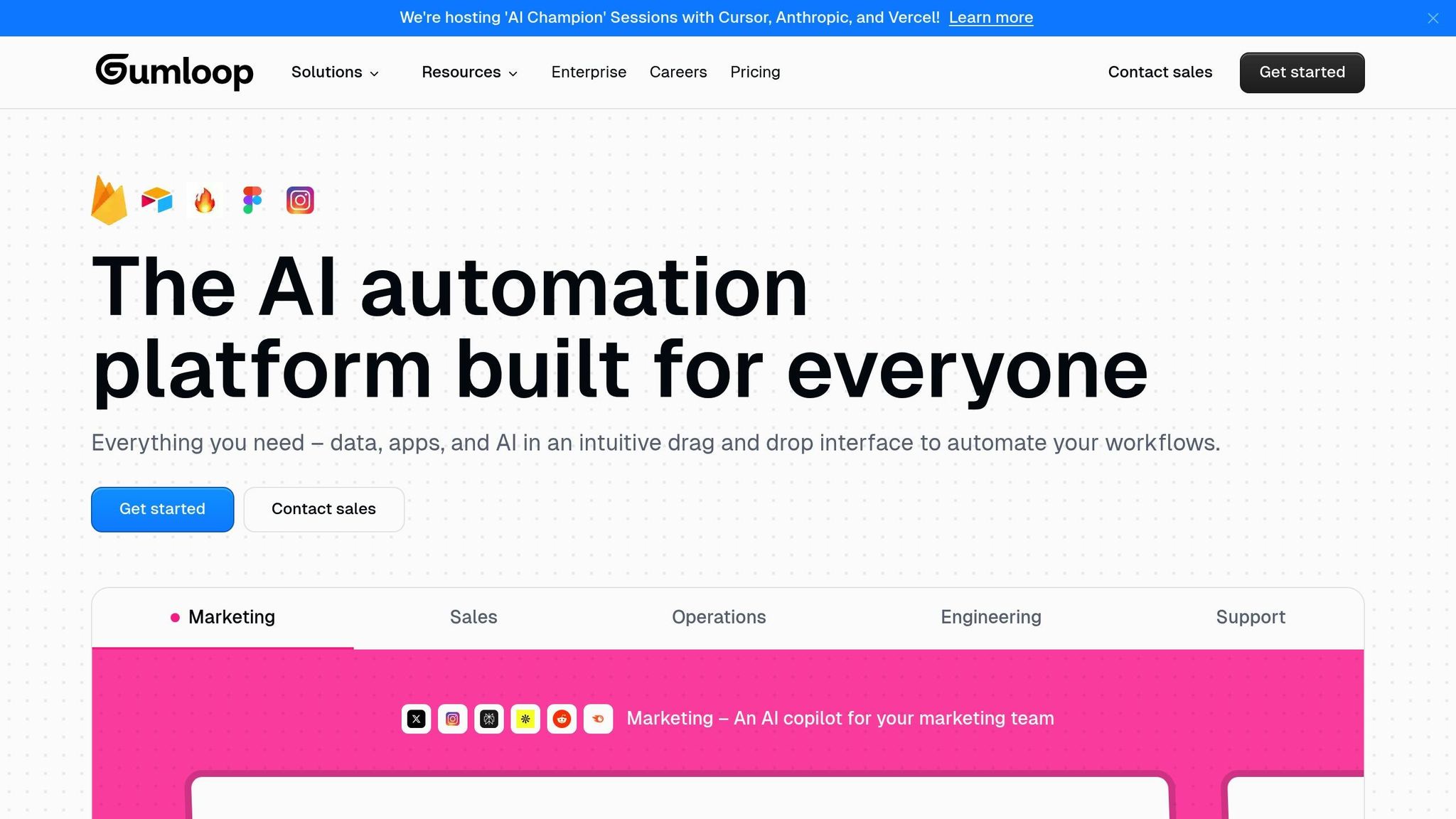
There isn't much verified information available about Gumloop's features, integrations, or pricing at this time. For the most accurate and up-to-date details on its low-code AI workflow tools, it's best to check Gumloop's official documentation.
More comparisons of pricing and features across different platforms are provided below.
6. FlowForma
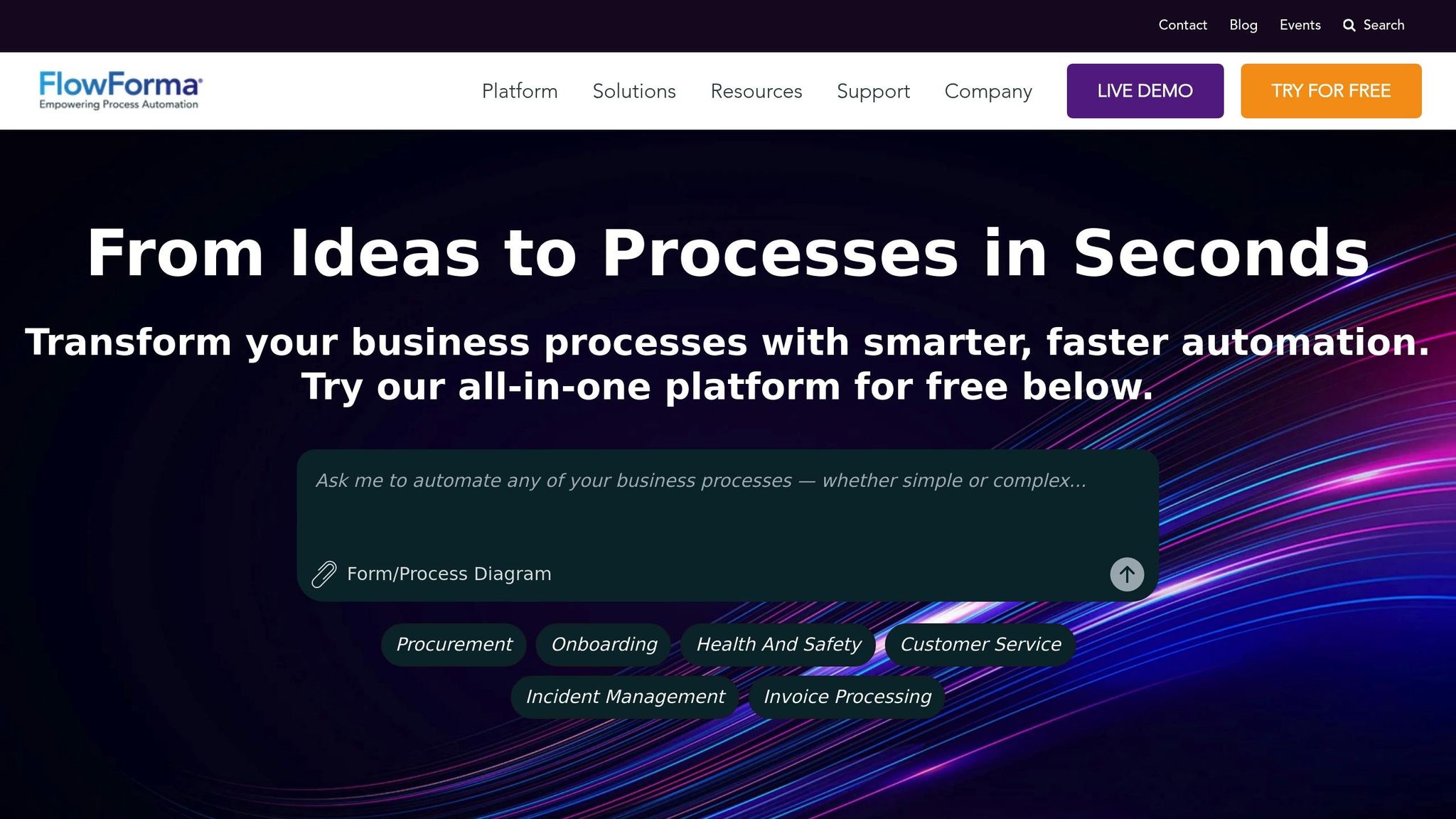
FlowForma is a business process management platform designed to replace paper-based processes with digital workflows, all through a low-code approach.
Low-code Accessibility
FlowForma simplifies workflow creation with its drag-and-drop form builder, allowing users to design digital forms and workflows without heavy IT involvement. The platform provides pre-built templates, making it easier to get started quickly.
Features like role-based permissions and approval routing are straightforward, using dropdown menus and checkboxes. Users can also implement conditional logic and branching workflows with intuitive if-then rules, avoiding the need for complex coding.
Workflow Customization and Scalability
FlowForma includes customizable dashboards that help track performance and pinpoint bottlenecks in workflows. It also supports API integrations to connect with existing systems, though the specifics depend on the environment in use.
The platform offers automated notifications and escalation rules, which can be configured to align with an organization’s hierarchy. Additionally, it supports process versioning, enabling teams to refine and improve workflows over time.
Pricing Transparency
FlowForma uses a subscription-based pricing model that adjusts based on usage. Pricing depends on factors like the number of users and the complexity of workflows. For tailored pricing details, businesses can contact FlowForma directly. This scalable approach is typical among platforms in the business process management space.
7. Domo
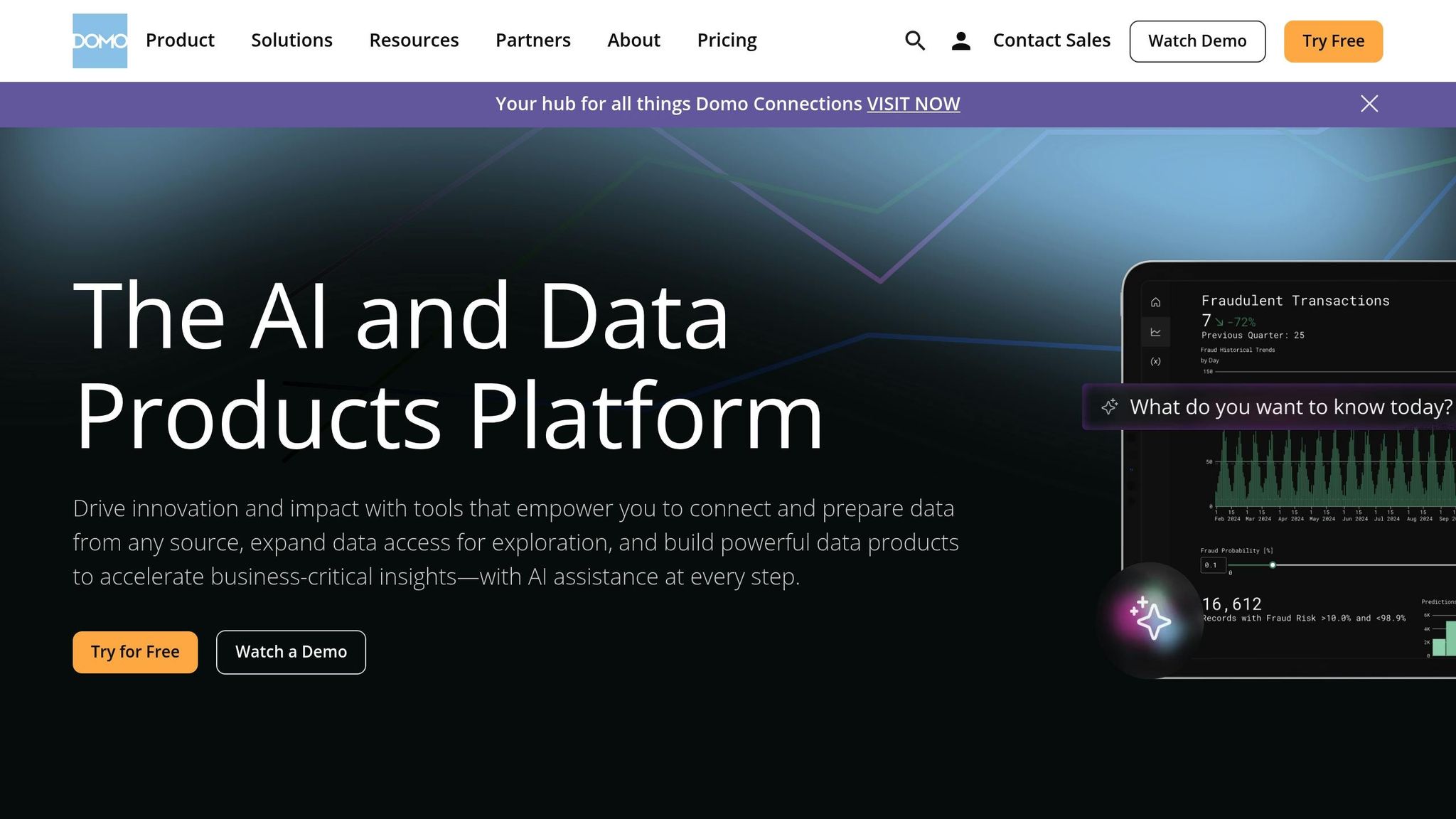
Domo wraps up our list with a fresh take on business intelligence by combining it with low-code automation. This cloud-based platform brings together data from multiple sources and streamlines essential processes. Unlike platforms with fixed or tiered pricing, Domo's pricing structure introduces a different set of considerations.
Pricing Transparency
Domo operates on a credit-based, consumption pricing model. The cost depends on factors like the amount of data, how often it's updated, and the use of features such as ETL jobs, dashboards, and AI-driven automations. However, getting a clear idea of costs upfront can be tricky since pricing requires contacting sales for a custom quote. This can make planning for annual budgets a bit more challenging.
New users can take advantage of a 30-day free trial with full access to the platform. After that, pricing is tailored to individual needs based on credit usage and any optional add-ons.
Feature and Price Comparison
Here's a breakdown of the features, pricing, and strengths of each tool to help you decide which one aligns with your business needs:
| Tool | Pricing Model | Free Access | Key Features | Integration Capabilities | Ideal For |
|---|---|---|---|---|---|
| Vellum AI | Subscription-based | Limited free access | AI model management and prompt engineering | Curated integration library | AI-first workflows |
| Creatio | Per-user subscription | Free trial available | Integrated CRM and sales automation | Extensive app integrations | Customer relationship management |
| Kissflow | Per-user pricing | Free trial available | Streamlined process and approval workflows | Broad integration support | Business process automation |
| Zapier | Task-based subscription | Generous free tier | Wide-ranging app connectivity and intuitive use | Vast app ecosystem | App connectivity and automation |
| Gumloop | Subscription-based | Basic free plan | Visual workflow building and team collaboration | Solid integration options | Creative and marketing workflows |
| FlowForma | Per-user pricing | Free trial available | Enterprise-grade compliance and form automation | Curated integration library | Regulatory and compliance workflows |
| Domo | Custom, usage-based pricing | Free trial available | Business intelligence and data visualization | Broad integration support | Data-driven decision making |
Each of these tools brings something different to the table. For example, Vellum AI is tailored for AI-first workflows, while Creatio focuses on integrating customer management. Kissflow simplifies process automation, and Zapier shines in connecting apps with ease. If you're looking for a visual workflow builder, Gumloop offers a user-friendly option for creative teams. FlowForma is ideal for compliance-heavy industries, and Domo provides robust data analytics and visualization.
When choosing the right tool, consider factors like pricing models, free access options, integration capabilities, and how well the tool can grow with your business. Each option caters to specific workflows and priorities, so align your choice with your unique business goals.
For more options, visit AI Apps - a centralized platform showcasing over 1,000 AI tools designed to meet diverse business needs.
Conclusion
Choosing the right low-code AI workflow tool can reshape how your business operates, streamlining processes and making the most of AI's potential. In today’s fast-paced, data-driven world, these tools are designed to tackle the growing need for efficiency and scalability. Each of the seven tools highlighted here is tailored to address specific business challenges.
When evaluating these tools, consider key factors like the level of AI integration, compatibility with your existing systems, the skill level of your team, overall costs, security measures, and scalability. Look for solutions with strong AI-driven features and flexible deployment options to ensure your automation strategy stays relevant as technology advances. Features like deep AI integration, prompt testing, and built-in business rules are becoming increasingly critical for effective workflow automation.
Ultimately, the best tool for your organization will depend on your unique needs. Whether your focus is on AI-first workflows, customer relationship management, process automation, app connectivity, creative collaboration, compliance oversight, or data visualization, there’s a solution that aligns with your goals and budget. Take the time to map out your business needs and match them to the tools that offer the most streamlined solutions.
Once you’ve narrowed down your options, consider exploring more than 1,000 AI tools available on AI Apps. The platform’s advanced filtering options make it easy to search by category, sub-category, and pricing model, helping you pinpoint the perfect tool for your workflow automation needs.
FAQs
What should businesses look for when selecting a low-code AI workflow tool from the list?
When choosing a low-code AI workflow tool, it's important to focus on a few key aspects: ease of use, scalability, and integration capabilities. These factors ensure the tool not only meets your current needs but also supports your business as it grows and evolves.
You’ll also want to assess whether the platform can handle complex workflows, facilitate team collaboration effectively, and uphold strict data privacy and compliance standards. These elements are critical for smooth operations and maintaining trust.
Another thing to keep in mind is how well the tool can simplify processes while adapting to changing business demands. Look for solutions that provide strong security measures and the flexibility to integrate with your existing systems. This will help ensure a smooth rollout and long-term efficiency.
How do pricing models for low-code AI workflow tools differ, and what should businesses consider when budgeting?
Low-code AI workflow tools come with a range of pricing options, from free plans to subscription-based tiers. Many platforms offer entry-level plans starting at around $9 per month, while others opt for per-user pricing models that typically begin at $35 per user per month, with costs rising as you add advanced business features.
When planning your budget, it’s essential to consider factors like team size, the specific features you need, and how much you expect to use the tool. Some platforms base their charges on the number of users, while others use tiered pricing tied to usage limits or the functionality included. Aligning the pricing model with your business requirements can help you get the most value without overspending.
Are low-code AI workflow tools easy to integrate with existing business systems, and what challenges might arise?
Low-code AI workflow tools can seamlessly integrate with existing business systems, but the journey isn't always smooth. Businesses might run into challenges like compatibility issues with older or custom-built systems, maintaining data quality and consistency, and tackling potential security risks. On top of that, resistance to new workflows or difficulties in staying compliant with regulations can add to the complexity.
To navigate these hurdles, a solid plan is essential. Prioritize implementing robust security measures and fostering organizational support for the changes. With careful preparation and the right strategies, these tools can help improve efficiency and simplify operations within your current setup.
